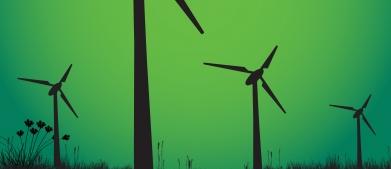[dropcap style=”font-size:100px; color:#992211;”]I[/dropcap]f ever there was an irony, it must be this one.
Spending Christmas huddled around a candle, knowing that the very winds that knocked out the grid could be flinging out the megawatts via wind turbine. Durrr….
Researchers from North Carolina State University and Johns Hopkins University have found that installing wind power plants at certain favorable locations in a power grid can make the grid more robust against extraneous disruptions.
Power transfer
Typically, the power flowing through the transmission lines of a power grid suffers from small “oscillations,” or deviations from the norm, after a disturbance. Generally, these oscillations are mitigated by controls inside the power generators. However, if the controls are not strong enough, the oscillations may be “sustained,” reducing the efficiency of power transfer and posing a threat to the stability of the grid. If not controlled properly, these oscillations can even lead to widespread power outages – such as the 1996 blackout that hit the West Coast of the U.S. The researchers found that, under certain circumstances, wind farms can worsen these oscillations if they are sited in the “wrong” locations. The problem is primarily due to the location of the wind farms in relation to the grid, and also due to the fact that the wind generator models are very different than that of conventional power generators. But if wind power is “injected” into the grid at certain favorable locations, then they can help to mitigate these oscillations.
The researchers found that, under certain circumstances, wind farms can worsen these oscillations if they are sited in the “wrong” locations. The problem is primarily due to the location of the wind farms in relation to the grid, and also due to the fact that the wind generator models are very different than that of conventional power generators. But if wind power is “injected” into the grid at certain favorable locations, then they can help to mitigate these oscillations.
Locations for wind farms that promise favorable impact
“The best way to solve this problem is to choose locations for wind farms that promise favorable impact on the oscillations,” says Dr. Aranya Chakrabortty, an assistant professor of electrical engineering at NC State and senior author of a paper describing the work. “However, due to various geographical factors it may not always be possible to install the plant at that favorable location. In that case, to counteract this problem, we have designed a technique that controls the flow of power from wind farms into the grid,” he adds. Specifically, the research team developed algorithms that match control efforts between wind farms and energy storage facilities. “By matching the behavior of the two controllers, we can produce the desired damping effect on the power flow and restore stable grid behavior,” Chakrabortty says.
Sources of renewable energy
This issue is particularly important because wind energy is one of the fastest growing sources of renewable energy. In the U.S., the rapid increase in wind farm installations is being accelerated by government mandates and the goal of providing 20 percent of the nation’s power needs through wind power by 2020.
Source: North Carolina State University
Photo: freedigitalphotos.com/watiporn

Some of the news that we find inspiring, diverting, wrong or so very right.



















